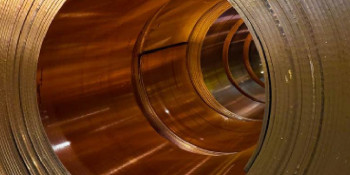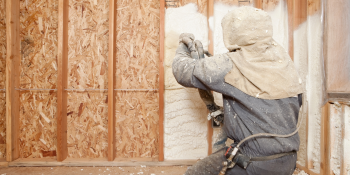Q&A Forums
Home Foam Post New Topic | Post Reply
| Author | Comments |
|---|---|
|
Mike Glace
Posted: Mar 03, 2007 10:03 PM
|
Home Foam
Hey you guys see there specs on half pound they say they got 24,000 board feet before.
|
|
SprayFoamSupply.com
Posted: Mar 03, 2007 11:21 PM
|
They are probably quoting the theoretical yield, which ticks me off! When manufacturers "stretch the truth" regarding yield, they are only hurting the contractors that they are selling foam to! .5lb foam means that 1 ft^3 weighs .5lb. Theoretically, 1,000lbs of liquid foam will yield 2,000 Ft^3 of foam. Multiply by 12 gives you 24,000 board feet. There is no allowance for the significant percentage of water that is in the B side and is blown off during the reaction. With .5lb foam, you need to figure 14,000-15,000 board feet as a realistic yield. If you get a little more, consider it a good day. |
|
Mike Glace
Posted: Mar 03, 2007 11:42 PM
|
I agree I only ever go 15,000 any thing else left over is extra for a small crawl or something if no extra no big deal. |
|
SprayFoamSupply.com
Posted: Mar 03, 2007 11:51 PM
|
I would not recommend using open cell foam in any crawlspaces. I always stress closed cell. George |
|
Mike Glace
Posted: Mar 03, 2007 11:55 PM
|
I do too the only time I will use open is on crawl space ceiling. For those who want the foam but not the close cell price. For the longest time all I ever sprayed in crawls was closed then mfg said open is ok so I started offering it but only on ceilings. |
|
Gerry Wagoner
Posted: Mar 04, 2007 04:47 PM
|
I agree with Geo. :). olger |
|
Circle-D
Posted: Mar 04, 2007 09:12 PM
|
George and Olger, Is that because of dampness associated with crawlspaces? and the open cell tendencies to absorb it? |
|
SprayFoamSupply.com
Posted: Mar 05, 2007 06:17 AM
|
That's it, anytime there is any sort of moisture, closed cell foam is the way to go. George |
|
Marc Kast
Posted: Mar 08, 2007 11:20 AM
|
We have seen results of 24k board ft in the summer months. We also offer a money back guarantee if you buy our foam and are not satisfied. The yield calculations you are using are not correct! There is 1100lbs of foam in a set of Home Foam, divide that number by the density and you get 2200 square ft. Now multiple that number by 12 to get board ft and you get 26400 board ft. That is the perfect yield which we agree cannot be achieved in field applications. We have spent considerable time and money developing the perfect open cell foam and urge any sceptics out there to give it a try, what have you got to loose. We not only sell the foam we apply it in Toronto Canada where the ambient temperatures are less than ideal |
|
Barry Wallett
Posted: Mar 08, 2007 11:53 AM
|
Hi Marc, You didn't include a link or your business name. |
|
Posted: Mar 08, 2007 12:03 PM
|
Marc, What is the weight of resin per gallon? I assume the resin is where you are getting the additional 100 pounds (not including the tare weight of the drums). Can you email me your spec sheet? info@gssfc.com Tim Granite State Spray Foam Co. |
|
Marc Kast
Posted: Mar 08, 2007 02:04 PM
|
I didn't include my company info because this is a discussion forum not a sales arena and I don't want to appear to be soliciting business here I'm just responding to inquiries and comments. Home Insulation Corp has a banner on this website which you can follow to our website www.homefoam.ca . The weight of our resin per gallon is refered to as the specific gravity of the material and is confidential information. It is not required to process the material. |
|
Posted: Mar 08, 2007 02:47 PM
|
Specific gravity and weight per gallon are different figures! It wouldn't be hard to figure out the wight per gallon of resin if I bought a set, so why wouldn't you just share that info? As a potential buyer of your product it would be nice to know all the specs beforehand. Tim Granite State Spray Foam Co. |
|
pete lustig
Posted: Mar 08, 2007 04:10 PM
|
Not sure why you are enquiring about weight/gal but Specific gravity will calculate that as Sp G is the ratio of weight to volume. As for density, from my knowledge, perfect yield is impossible. The way you get closest is generally by reducing skin thickness on the surface as well as reducing the loss on the substrates. Obviously the colder or bigger heat sink on the substrate the bigger loss due to thickness of skin (hense the summer has higher yields). The formula also dictates the thickness of these skins as the formula can be optimized to have minimal skin as well. You pay by the pound so the skins are costing you money. Also, in place density is usually calculated without the skins so usually the yield is the difference between the perfect conversion of yield and the loss you've had on the skins and substrates. Weight per gallon or specific gravity will effect the weight versus volume ratio however you are buying by the pound so really has no bearing. |
|
Marc Kast
Posted: Mar 08, 2007 04:42 PM
|
Thanks Pedro I couldn't have said it better. We have optimized our foam to get the best yield possible under varying conditions. Data sheets are available on our website, as well as, all testing data. I can be contacted at marckast@homefoam.ca |
|
Posted: Mar 08, 2007 05:43 PM
|
I am trying to figure out how 100 extra pounds of material can equate to an extra 8K bdf (assuming most 1/2# foam is yielding 16Kbdf vs. your claimed 24K bdf.). Specific Gravity as I have always understood it is the ratio of the density of the material to the density of water. Not weight to volume. I am asking about the weight, because I know that I get 450#'s of resin in my foam and it weights 9# per gallon that gives me 50 gallons of resin. If you are filling right to the top and getting 55 gallons at 9# that would be 495#'s. I know I get 53 gallons of iso for 550#'s. I am just trying to figure out where you are getting the extra weight. Inquiring minds want to know, I am not doubting you, your foam, or your installers. I am just curious, take no offense! Tim Granite State Spray Foam Co. |





























